Going to extremes
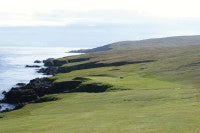 I spend a fair bit of my time visiting sporting facilities across England, Scotland, Wales and Ireland. In many instances their location has a bearing on how they are managed and maintained. No two sites are the same. Geographical location, climatic conditions and the physical nature and properties of the underlying soils all play a part in the ongoing maintenance of each venue.
I spend a fair bit of my time visiting sporting facilities across England, Scotland, Wales and Ireland. In many instances their location has a bearing on how they are managed and maintained. No two sites are the same. Geographical location, climatic conditions and the physical nature and properties of the underlying soils all play a part in the ongoing maintenance of each venue.
But, have you ever wondered where the most extreme sporting venues are in the British Isles?
It was a fair bet that the most northerly would be on one of the Scottish islands and, equally, that the most southerly would likely be in the Channel Islands.
But, what of east and west? And what type of venue were they - football, golf, cricket?
Well, with the aid of Google maps, countless phone calls, and a bit of skulduggery, I have been able to pinpoint the four most extreme sites in
the British Isles.
Of the four, two are golf courses, the third a set of bowling greens and, the fourth, a general sports turf facility that provides football and cricket.
Laurence Gale MSc dons his deerstalker and gets out his spyglass!
Whalsay Golf Club
The most northerly facility is Whalsay Golf Club on Whalsay Island which lies off the east coast of Shetland's Mainland at coordinates 60°22' N 0°55' W. The mean annual rainfall is 924.4mm. The average air temperature in January is 3.3°C and, in August, 16.1°C
Whalsay lies off the east coast of Shetland's largest island, Mainland, and is reached by a regular 30 minute ferry link from Laxo. The name comes from the Old Norse meaning Whale Island, though, for generations of Scottish fishermen, it has been better known as The Bonny Isle.
The island measures five and a half miles from south west to north east, and is two miles wide. With a population of around a 1000 it is one of Shetland's more densely populated islands.
 Visitors travelling to Whalsay by ferry arrive in Symbister Harbour, which is the focus of island life and activity. Those arriving by air will find that the airstrip, at Skaw on the northern tip of the island, is also the home of Whalsay Golf Club, so play stops if there is an incoming or outgoing charter flight! It is likeley that, as well as being the most northerly club in the British Isles, it is the only one in the world that includes an airstrip amongst its hazards!
Visitors travelling to Whalsay by ferry arrive in Symbister Harbour, which is the focus of island life and activity. Those arriving by air will find that the airstrip, at Skaw on the northern tip of the island, is also the home of Whalsay Golf Club, so play stops if there is an incoming or outgoing charter flight! It is likeley that, as well as being the most northerly club in the British Isles, it is the only one in the world that includes an airstrip amongst its hazards!
Not unwelcome distractions include gulls, skuas, seals, otters and the wonderful site of porpoises swimming just offshore.
Golf has been played on the Shetland Islands since the late nineteenth century when the Laird of Shetland and his family took an interest in the sport. There are only two other courses - Shetland, an 18 hole course just outside Lerwick and the 9 hole Asta course just outside Tingwall.
The Whalsay Golf Club was formed in 1976. The club received various small grants for grass cutting machinery and, until about 1989, club members did all the work on the course on a voluntary basis.
In 1989 eighteen new tees were built and the course was recognised by the Scottish Golf Union in 1990. In 1992 the Ladies course was recognised by the SGU.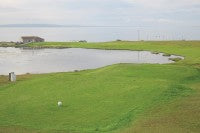
The first Greenkeeper was employed in 1994 and the new clubhouse was built in 1996 when the club purchased land close to the 18th green.
The club was delighted to have been part of the Natwest Inter Island Games, held in Shetland in 2005. Club membership has increased rapidly over the years.
Today the course is managed and maintained by two Greenkeepers, John Simpson and, err, John Simpson, both of whom are retired fishermen. John senior is 60 years old and 'junior' is 59. They are not related.
They work full time in the summer months from 8.00am until 4.00pm. This is the time of year when it never gets properly dark - known in Shetland as "the Simmer Dim" - and the course is, literally, in constant use.
During the winter months the two Johns' work part time. The course is often closed due to the extreme weather conditions that prevail on this remote island. The wind chill factor alone means that the grass will just lie dormant for weeks on end. Even in summer the wind can reach Force 8!
Various improvements to the course were carried out between 1997 and 2003, including the construction of seven 'proper' greens. Up until this point all greens were just mown out of the landscape. This is still the case with the remaining eleven but, with the constant care and attention they have been given, they are now of a high standard and their structure suits the Whalsay climate perfectly.
The average size of the greens is 500 square metres and are cut regularly using a Ransomes Jacobsen Tri-King maintaining a height of cut of 3-4mm in summer and 5-7mm at other times. Tees are cut to 10mm and fairways are are maintained at 11mm during periods of growth.
There are just twelve bunkers on the course and no irrigation system.
Whalsay Golf Club, whilst having a links feel, is not classified as such due to the peat soil that it sits on. This is a course that is as close to nature as it can possibly get.
Florence Boot Playing Field
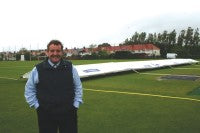 The most southerly facility is the Florence Boot Playing Field situated in the southeast corner of the Island of Jersey at coordinates 49°10' N 2°5'W. The mean annual rainfall is 994.1 mm. The average air temperature in January is 6.4°C and, in August, 25°C
The most southerly facility is the Florence Boot Playing Field situated in the southeast corner of the Island of Jersey at coordinates 49°10' N 2°5'W. The mean annual rainfall is 994.1 mm. The average air temperature in January is 6.4°C and, in August, 25°C
The FB Playing Field occupies over twenty acres in the south east of the island. FB stands for Florence Boot who was the founder of Boots the Chemist.
During the war years the main field was used for crop growing, plus a glasshouse nursery and a small allotment. The football pitch formed part of the field and was used as a games area.
After the war years the whole area was turned into a playing field and run by the FB Trust. In the early fifties the Trust bequeathed the playing fields to the people of the island for the sole use of sport. It is now run by the States of Jersey.
The field was re-levelled and grassed over and used predominantly for football and rugby. Hockey, which had previously been played on the beach, was a later addition. A cricket square was added in the early sixties.
In those early years four small football pitches and two larger pitches occupied the whole site but, because they were below sea level, were prone to flooding. There were no vertidrain machines back then, just an old Sisis slit tine and a boat!
For cricket there was just the one grass square and two other coconut matting wickets.These often needed stretching due to the heat shrinking them. And, if that wasn't enough, on one particular hot summer's day the field dried out so much the grass actually caught fire! Not surprisingly, the field was closed to the public until rain had reduced the risk.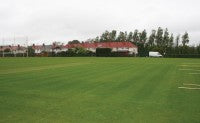
Ian John Le Marquand has been Head Groundsman for twenty six years. Things have changed, and not all for the good. In the early days there were five staff, but now it's just two plus a seasonal temp who helps out in the cricket season.
The site now has three senior football pitches and three junior/primary pitches, together with a grass hockey pitch. The pitches are vertidrained three to four times from September to March. They are mown and marked out once a week and chain harrowed and light rolled when necessary.
The area which was prone to flooding is now a synthetic 400 metre, 6 lane athletics track with all the associated field events and full competition floodlighting. The infield now has a very effective drainage system which allows it to be constantly used for football and athletics training.
During summer cricket takes over. There are between fifty and sixty matches played on the grass wickets each season, as well as games every weekday evening on artificial Notts Turf strips The facilities are heavily used by local schools and for friendly games. There are also four permanent Notts Turf cricket nets.
Other facilities include two floodlit netball courts, a table tennis centre, judo and karate hall, weights room and three pavilions.
Apart from the cricket squares, all the mowing is carried out with a set of three Lloyds Leda gang mowers. During the cricket season the three cricket outfields are mown twice a week.
Due to the higher temperatures experienced on Jersey the grass rarely stops growing, so the winter sports pitches are cut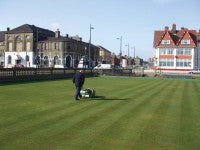 as and when required.
as and when required.
Great Yarmouth Bowling Club
The most easterly facility is Great Yarmouth Bowling Club in Norfolk at coordinates 52°36' N 1°44' E. The mean annual rainfall is 542.mm. The average air temperature in January is 3°C and, in August, 20°C
Britannia bowling greens were built in 1930 by Great Yarmouth Borough Council as public greens. The five greens were originally laid with Cumberland turf on natural sand, being only yards from the beach.
In 1933 the Britannia Bowls Club was formed and now plays on the greens that are, in theory, also open to the general public. However, in practice that rarely happens!
In August 1945 the Great Yarmouth Festival of Bowls was launched and the event has been run every year since then. It is reckoned to be the biggest four-week outdoors bowls tournament in the UK, attracting over 1,500 entrants in the twelve different categories.
The greens are maintained by Great Yarmouth Borough Services Limited, a company partnership set up between the council and Norfolk County Services.
They are mown three times a week during the playing season (May to October).
The Head Greenkeeper is David Howard, and he has three assistants, Darren Rushbrook, Shaun Moore and Joe Smith.
The greens are maintained using Dennis FT610 cassette nine bladed cylinder mowers that come with scarifier and verticutting units.
During the season the greens are cut three times a week with heights of cut maintained between 5-7mm for general play and down to 5mm for tournament play. The greens are verticut once a month and vertidrained when conditions allow.
The summer feeding programme involves three applications of Pentagon Prestige fine turf fertiliser (spring/summer mix) 14:4:8 + 2% fe + 2% mg + 12.76% s.
Winter maintenance begins with the end of season renovations that, in general, involves solid tine spiking, topdressing and overseeding. Every third year the greens are hollow cored.
 The winter feeding programme consists of one application of Pentagon Prestige (autumn/winter mix) 6:6:12 +2% fe + 2% mg +11.8% s. The greens are cut monthly at a height of 15mm.
The winter feeding programme consists of one application of Pentagon Prestige (autumn/winter mix) 6:6:12 +2% fe + 2% mg +11.8% s. The greens are cut monthly at a height of 15mm.
Dingle Golf Links
The most westerly facility is Dingle Golf Links, Ceann Sibéal, at Ballyferriter, Dingle, Co. Kerry in Ireland at coordinates 52°10' N 10°26' W. Mean annual rainfall is 1600mm. The average air temperature in January is 5°C and, in August, 23°C
Nestled on the edge of Ireland's dramatic southwest coastline, Dingle Golf Links is a very special place to visit. For many it is the truly special people of the Dingle Peninsula that make their time here so memorable. For others it is the quite breathtaking scenery of the peninsula revealing, as it does, its hidden bays, small fishing villages, glorious mountains and the Blasket Islands.
The course is billed as "a golfing sanctuary where the Atlantic Ocean meets the worlds most beautiful landscape and golfers wonder why they ever have to leave".
Ceann Sibéal was founded in 1924. The great Irish architect, Eddie Hackett, who passed away in 1996 at the age of 86, is credited as the architect. He also designed other favourites such as Carne, Connemara, Enniscrone and Waterville Golf Links.
Ireland's beloved Ryder Cup hero, Christy O'Connor Jr., oversaw a modern-day update in the 1990s.
The course is managed by Jerry Mulvihill, who has spent his whole life involved in the game, having started his association with golf when, at the tender age of seven, he caddied at the famous Ballybunion Golf Club and, some years later, went on to work there in a greenkeeping capacity.
Since then Jerry has worked at several courses, both at home and abroad, which included spells in Germany and America. He follows the methods of Jim Arthur when it comes to maintaining the course - raw, lean and mean.
Jerry has now been at the Dingle for eight years. His brief was to revert the course to a true links course. He is beginning to win the war on Poa with his programmes of starving turf of fertiliser and water. Constant aeration, overseeding and topdressing, combined with the specific use of chemicals, is gradually eradicating poa and rye grasses.
 The Dingle Links is now getting back to a true links style course with fescues bents and Marram. The course could not be described as manicured, and Jerry believes it is as natural and raw as any fine links course in Ireland.
The Dingle Links is now getting back to a true links style course with fescues bents and Marram. The course could not be described as manicured, and Jerry believes it is as natural and raw as any fine links course in Ireland.
Heights of cut are:
Greens from 4.5mm - 5.5mm
Tees from 7mm-12mm
Fairways from 7mm-12mm
Semi roughs from 25mm-75mm
Overseeding starts in February on a monthly basis through to September coupled with constant aeration and topdressing using very little irrigation and fungicides.
During the first three to four years of Jerry's tenure the only disease that appeared was red thread, a sign of nutrient deficiency. If fusarium comes in he leaves it to kill the Poa and then reseeds with fescues.
Being on the coast the course suffers from high winds and heavy rainfall which, in the past, have affected grass growth. Rootmass is everything. During Jerry's time at Dingle it has gone from having no grass and little rootmass to a healthy sward with roots to 150-220mm (6"-8"). He never really worries about his greens even if it is blowing a hurricane or if there is a drought. His greens are healthy and strong and look after themselves in these tough conditions.
